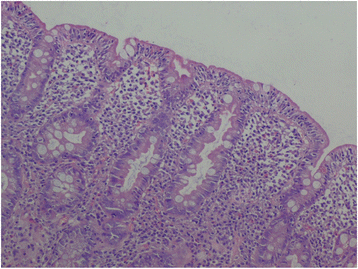Refeeding syndrome in adults with celiac crisis: a case report
- PMID: 29382373
- PMCID: PMC5791168
- DOI: 10.1186/s13256-018-1566-6
Refeeding syndrome in adults with celiac crisis: a case report
Abstract
Background: Refeeding syndrome is a rare and life-threatening pathology with polyvisceral manifestations occurring in severely malnourished patients. It is rarely described in adults with celiac disease.
Case presentation: We report the case of a 28-year-old Tunisian woman followed up for celiac disease, who did not adhere to the gluten-free diet. She presented to our hospital with celiac crisis manifested by severe diarrhea, and metabolic and electrolyte disturbances. The treatment of electrolyte abnormalities, hydration, and nutritional support was marked by the occurrence on the fifth day of refeeding syndrome with psychomotor agitation followed by respiratory distress and a state of cardiogenic shock.
Conclusions: Refeeding syndrome is still under-recognized. It should be systematically prevented for high-risk patients. Nutritional support in patients with celiac crisis should be monitored carefully since the risk of refeeding syndrome is very high with a poor prognosis.
Keywords: Celiac crisis; Celiac disease; Refeeding Syndrome; feeding.
Conflict of interest statement
Ethics approval and consent to participate
Not applicable.
Consent for publication
Written informed consent was obtained from the patient’s next-of-kin for publication of this case report and any accompanying images. A copy of the written consent is available for review by the Editor-in-Chief of this journal.
Competing interests
The authors declare that they have no competing interests.
Publisher’s Note
Springer Nature remains neutral with regard to jurisdictional claims in published maps and institutional affiliations.
Figures
Similar articles
-
Celiac crisis in adults: a case report and review of the literature focusing in the prevention of refeeding syndrome.Rev Esp Enferm Dig. 2017 Jan;109(1):67-68. doi: 10.17235/reed.2016.4073/2015. Rev Esp Enferm Dig. 2017. PMID: 26912167
-
Refeeding syndrome in children in developing countries who have celiac disease.J Pediatr Gastroenterol Nutr. 2012 Apr;54(4):521-4. doi: 10.1097/MPG.0b013e318242fe1d. J Pediatr Gastroenterol Nutr. 2012. PMID: 22157921
-
Nutritional management of celiac crisis in an elderly adult: A case report of the rare presentation of celiac disease in a 75-y-old woman.Nutrition. 2020 Nov-Dec;79-80:110858. doi: 10.1016/j.nut.2020.110858. Epub 2020 May 19. Nutrition. 2020. PMID: 32599449
-
Refeeding syndrome: treatment considerations based on collective analysis of literature case reports.Nutrition. 2010 Feb;26(2):156-67. doi: 10.1016/j.nut.2009.11.017. Nutrition. 2010. PMID: 20122539 Review.
-
Refeeding syndrome.Pediatr Clin North Am. 2009 Oct;56(5):1201-10. doi: 10.1016/j.pcl.2009.06.006. Pediatr Clin North Am. 2009. PMID: 19931071 Review.
Cited by
-
One Page in the History of Starvation and Refeeding.Rambam Maimonides Med J. 2024 Apr 28;15(2):e0010. doi: 10.5041/RMMJ.10524. Rambam Maimonides Med J. 2024. PMID: 38717179 Free PMC article. Review.
-
Celiac Crisis: an unusual presentation of gluten-sensitive enteropathy.Autops Case Rep. 2018 Jul 30;8(3):e2018027. doi: 10.4322/acr.2018.027. eCollection 2018 Jul-Sep. Autops Case Rep. 2018. PMID: 30101133 Free PMC article.
-
Life-threatening onset of coeliac disease: a case report and literature review.BMJ Open Gastroenterol. 2020 May;7(1):e000406. doi: 10.1136/bmjgast-2020-000406. BMJ Open Gastroenterol. 2020. PMID: 32381744 Free PMC article. Review.
-
Celiac crisis, a rare occurrence in adult celiac disease: A systematic review.World J Clin Cases. 2019 Feb 6;7(3):311-319. doi: 10.12998/wjcc.v7.i3.311. World J Clin Cases. 2019. PMID: 30746372 Free PMC article.
References
-
- Anne C, Barras M, Esther G, Pauline CB. Le syndrome de renutrition inappropriée: la clé du traitement est la prévention. Clin Nutr. 2011;25:86–90.
-
- Buzzi M, Limonta A, Pichard C, Stirnemann J. Refeeding syndrome: practical issues. Rev Med Suisse. 2015;11:1888–91. - PubMed
-
- Quinty F, Portet N, Parcevaux M, Couret D, Ocquidant P. Choc cardiogénique et syndrome de renutrition inappropriée. Clin Nutr. 2015;29:26–8.
-
- Kraaijenbrink BV, Lambers WM, Mathus-Vliegen EM, Siegert CE. Incidence of refeeding syndrome in internal medicine patients. Neth J Med. 2016;74(3):116–21. - PubMed
Publication types
MeSH terms
LinkOut - more resources
Full Text Sources
Other Literature Sources
Medical


